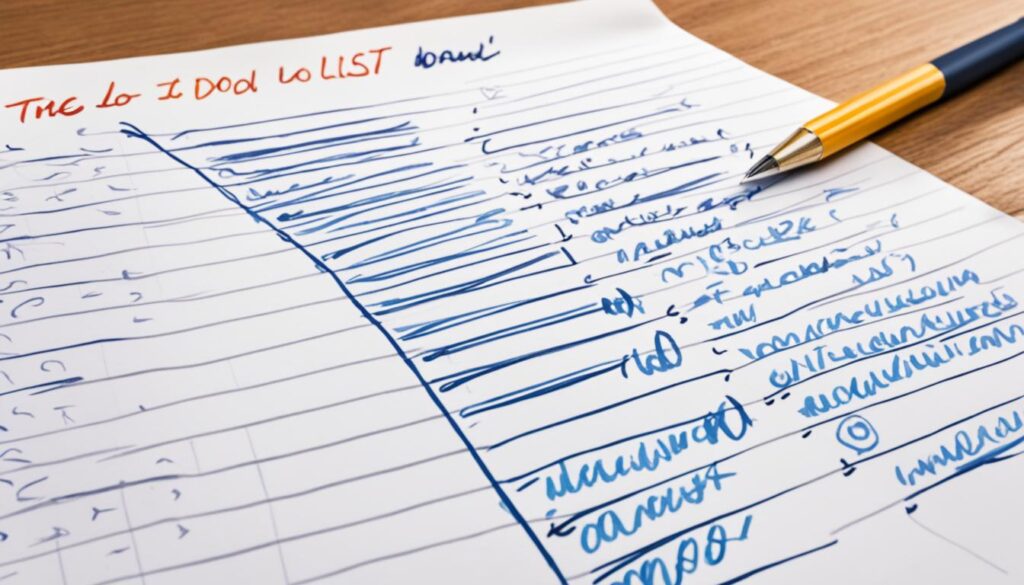Bust Time Management Myths & Boost Your Productivity

“The key is not to prioritize what’s on your schedule, but to schedule your priorities.” – Stephen Covey
Managing time effectively is a skill that can significantly impact your productivity and success. However, there are many myths and misconceptions surrounding time management that can hinder your progress. In this article, we will debunk some of the most common time management myths and provide you with strategies to boost your productivity and make the most of your time.
Key Takeaways:
- Avoid common time management myths that can hinder your productivity
- Question the effectiveness of relying solely on a to-do list
- Assess your current time management skills objectively
- Focus on quality and results, not just quantity
- Consider the benefits of batching tasks and task switching
The Myth of the To-Do List
One of the most prevalent time management myths is that using a to-do list is the key to productivity. While to-do lists can work for some people, they can also be demotivating and lead to a sense of overwhelm. Instead of relying solely on to-do lists, consider planning tasks at specific times throughout your day or limiting your to-do list to a few important items. This approach can help you prioritize and focus on the most important tasks, ultimately increasing your productivity.

When you have a long list of tasks to complete, it’s easy to feel overwhelmed and unsure where to start. However, trying to tackle everything on your to-do list at once can lead to burnout and a lack of focus. Instead, try breaking down your tasks into smaller, more manageable chunks. Prioritize them based on urgency and importance, and allocate specific time slots for each task. By scheduling your tasks, you can ensure that you give them the attention they deserve and prevent yourself from feeling overwhelmed.
Additionally, consider limiting your to-do list to a few important items each day. This allows you to focus on the tasks that will have the most significant impact on your goals and priorities. By narrowing down your to-do list, you can avoid spreading yourself too thin and ensure that you give your full attention to each task.
Remember, the purpose of a to-do list is to help you stay organized and focused, not to overwhelm you with an endless list of tasks. Find a method that works best for you, whether it’s planning tasks at specific times or limiting your to-do list, and adapt it to your own preferences and workflow. By debunking the myth of the to-do list, you can find a time management strategy that maximizes your productivity and helps you achieve your goals.
Debunking the Myth of Already Being Productive
Many people believe that they are already maximizing their productivity and can’t improve further. However, self-assessment and objective evaluation of how you spend your time can highlight areas for improvement. Use tools like time tracking applications or simply track your activities with pen and paper to gain insights into how you are truly utilizing your time. By identifying time-wasting activities and implementing changes, you can optimize your productivity and achieve better results.
Don’t fall into the trap of thinking that you have mastered time management skills. There is always room for improvement when it comes to productivity. Take the time to reflect on your daily routines and habits. Are there any activities that are eating up your time without providing significant value? By conducting a self-assessment, you can identify areas where you can make adjustments and maximize your efficiency.
Time tracking is an effective method for gaining a clear understanding of how you use your time. With the help of time tracking applications, you can monitor the time spent on different tasks and activities. Alternatively, you can jot down your activities throughout the day and review them later. This self-awareness allows you to identify patterns, time-wasting activities, and areas where you can make improvements.

Benefits of Self-Assessment and Time Tracking
Self-assessment and time tracking provide you with valuable insights into your productivity. They enable you to:
- Identify time-wasting activities: Pinpoint tasks or behaviors that consume excessive time without contributing to your goals. By eliminating or optimizing these activities, you can make better use of your time.
- Set realistic priorities: When you have a clear picture of how you spend your time, it becomes easier to determine which tasks are truly important. Prioritize tasks that align with your goals and have the most significant impact.
- Identify productivity patterns: Notice when you are most productive and energized throughout the day. This knowledge can help you schedule high-priority tasks during your peak performance periods.
- Optimize your schedule: With a deeper understanding of your time usage, you can make more informed decisions about how to structure your day. Allocate blocks of time for specific tasks or create a routine that aligns with your natural productivity rhythms.
Take Control of Your Productivity
Don’t settle for the belief that you are already as productive as you can be. Embrace self-assessment and time tracking as powerful tools to optimize your productivity. Use the insights gained from these practices to make informed decisions about how you allocate your time and energy. By continuously evaluating and improving your time management skills, you can unlock your full potential and achieve greater success.
| Benefits of Self-Assessment and Time Tracking |
|---|
| Identify time-wasting activities |
| Set realistic priorities |
| Identify productivity patterns |
| Optimize your schedule |
Time Management Myth: Doing More in Less Time
When it comes to time management, many people believe that doing more tasks in less time is the ultimate goal. However, this is a common misconception that can lead to inefficiency and burnout. True time management is not about cramming as many tasks as possible into your schedule. Instead, it’s about focusing on effectiveness, prioritization, and the overall impact of your work.
Instead of obsessing over quantity, shift your perspective to quality and results. Take the time to identify the most important tasks that align with your goals. These tasks are the ones that will have the greatest impact on your success. By prioritizing these essential tasks, you can ensure that your time and energy are allocated where they will make the most significant difference.
Eliminating or delegating non-essential tasks is another key aspect of effective time management. Not every task holds equal value, and by freeing up time from less important activities, you create more room for what truly matters. Focus on the tasks that align with your objectives and contribute to your long-term success.
Benefits of Prioritization and Impact
- Increased efficiency: When you prioritize and focus on tasks with the most impact, you can maximize your efficiency. By devoting your time and resources to the most important activities, you avoid wasting resources on low-value tasks.
- Enhanced effectiveness: Prioritization allows you to concentrate your efforts on the tasks that will bring the most significant results. You can avoid spreading yourself too thin by focusing on what truly matters, leading to a higher level of effectiveness in your work.
- Reduced stress: By focusing on the most critical tasks and eliminating non-essential ones, you can alleviate the stress and overwhelm that often accompany a packed schedule. By carefully selecting your priorities, you can create a more balanced and manageable workload.
Remember, effective time management is not about doing more in less time. It’s about working smarter, not harder. By embracing prioritization and the impact of your tasks, you can achieve greater efficiency and effectiveness in your work. So, let go of the myth that quantity equals success and start prioritizing the tasks that truly matter.

| Myth | Reality |
|---|---|
| Quantity is the key to success in time management. | Prioritizing the most important tasks leads to greater efficiency and effectiveness. |
| Cramming more tasks into the schedule will result in better time management. | Identifying the essential tasks and allocating time accordingly improves productivity. |
| Doing more tasks in less time leads to greater productivity. | Focusing on quality and results rather than quantity enhances overall productivity. |
The Myth of Completing One Task Before Moving On
When it comes to managing your time effectively, the conventional wisdom suggests that you should complete one task before moving on to the next. However, this approach is not always practical or efficient. Each task requires a different level of focus and concentration, and sticking to one task until completion can hinder your productivity.
Instead, you can optimize your productivity by utilizing time chunking and batching tasks. Time chunking involves working on specific tasks during designated time intervals. By grouping similar tasks together and allocating dedicated time slots for each, you can make progress on multiple tasks without sacrificing focus.
For example, if your work involves both content creation and data analysis, you can set aside a specific time chunk for writing and another for analyzing data. This allows you to switch between tasks while still making progress and taking advantage of different mental states.
Batching tasks is another effective technique for managing your workload. Instead of completing one task at a time, you can group similar tasks based on their nature or required resources. For instance, you can dedicate a block of time to responding to emails, another for making phone calls, and another for conducting research. By doing so, you minimize the time wasted on task switching and maximize your efficiency.
It’s important to find the right balance between task completion and task switching. While completing tasks is crucial for progress, switching tasks strategically can prevent burnout and keep your mind fresh. By incorporating time chunking and task batching into your time management approach, you can enhance your productivity and work on multiple important tasks simultaneously.
Benefits of Task Chunking and Batching:
- Enhanced productivity by working on multiple tasks simultaneously
- Optimized focus and concentration through dedicated time intervals
- Reduced time wasted on task switching
- Streamlined workflow by grouping similar tasks together
- Prevention of burnout through strategic task switching

| Task Completion Method | Pros | Cons |
|---|---|---|
| Completing one task before moving on | – Provides a sense of accomplishment – Focused on task completion |
– Lack of flexibility – Dependencies on external factors |
| Time chunking and task batching | – Increased productivity – Ability to work on multiple tasks simultaneously |
– Requires effective planning and organization – Potential challenges in finding the right balance |
Conclusion
Effective time management is the key to achieving your goals and maximizing your productivity. By debunking common time management myths and adopting proven strategies, you have the power to take control of your time and increase your efficiency.
Remember that time management is a skill that can be learned and improved upon. It’s not about trying to do more in less time or completing one task before moving on. Instead, it’s about prioritizing your tasks, focusing on what truly matters, and finding the right balance between task completion and task switching.
Embrace the strategies outlined in this article and start implementing them in your daily life. Use technology to track your activities and gain insights into how you’re utilizing your time. Eliminate non-essential tasks and allocate your time to the ones that have the most significant impact. By doing so, you’ll unlock your full potential and enjoy unparalleled productivity.
FAQ
Are to-do lists the key to productivity?
While to-do lists can work for some people, they can also be demotivating and overwhelming. It’s better to plan tasks at specific times or limit your to-do list to a few important items to prioritize and focus on the most important tasks.
Can’t I improve my productivity any further?
Self-assessment and objective evaluation of how you spend your time can highlight areas for improvement. By using tools like time tracking applications or tracking activities with pen and paper, you can identify time-wasting activities and implement changes to optimize your productivity.
Does better time management mean cramming more tasks into my schedule?
No, true time management is about identifying the most important tasks and prioritizing them for maximum impact. Focus on quality and results, not quantity. Determine essential tasks aligned with your goals and eliminate or delegate non-essential tasks to free up time for what truly matters.
Should I finish one task before moving on to the next?
Not always. Different tasks require different levels of focus and concentration. Consider working in time chunks or batching similar tasks together. This allows you to switch between tasks while still making progress and taking advantage of different mental states, ultimately boosting your productivity.






